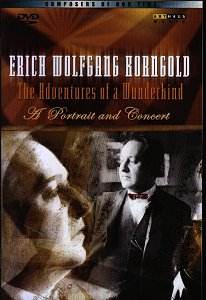After releasing the abysmal and outrageous Opéra
National du Rhin-Strasbourg’s 2001 production of Erich Wolfgang
Korngold’s Die Tote Stadt, Arthaus have now redeemed themselves
with this excellent celebration of the life and music of the composer.
The Portrait section covers the life of
Korngold taking us, as Korngold would have experienced it, from
the fantasy world of old Habsburg Vienna to the Warner Bros. ‘dream
factory’ in Hollywood. With comments from Korngold experts and
those who knew him the portrait moves through the period of the
early works – so incredibly assured and mature from a little boy
barely in his teens – through his early operatic successes and
his work for Viennese operetta to his career in Hollywood and
finally to disillusion as his music was felt to be out of joint
with the times after the end of World War II. It is illustrated
by Korngold’s own home movie pictures plus many, many photographs
– some familiar to readers of the biographies by Brendan G. Carroll
and Jessica Duchen – and many more less familiar images.
Biographer and President of the International
Korngold Society, Brendan G. Carroll contributes many insights
including the comment: "He is the only example of a composer
prodigy I know who had a fully formed musical personality right
from the start. As a little boy in his compositions, his was writing
like an adult. Amazed, Richard Strauss, Mahler, Kreisler etc recognised
that he was writing like they did. Korngold was also a magnificent
pianist developing his prodigious skill after only a few lessons
from a needy relative." Conductor Hugh Wolff comments: "His
music is full of emotion. It’s rich melodic and expressive. As
an orchestral conductor you stand in awe of his orchestral abilities
from his very early works like the Schauspiel Overture (1911)
onwards. They are amazingly sophisticated, elaborate and detailed.
He had an excellent ear for colour and balance and original sounds."
There are abundant musical examples beginning
with early works like The Snowman, the Dramatic
Overture and the Piano Trio. There is music from the operas:
Violanta, Die Tote Stadt, Das Wunder der Heliane, and Die
Kathrin. From Violanta we hear the opening music set
against dramatic wintry images of Venice and Brendan G. Carroll
draws attention to the extraordinary unsettling atmosphere created
by Korngold’s eerie "Violanta chord" spaced across the
whole orchestra, arching four and a half octaves, a device that
"could have been written by no other composer." Against
equally atmospheric twilight autumnal pictures of Bruges we hear
Paul’s Act II aria from Die Tote Stadt, as he wanders through
Bruges to eventually linger in front of Marietta’s house pondering
on his new love for her and his guilt at betraying the memory
of his beloved deceased wife. Later from the same opera we hear
something of the very popular Fritz’s ‘Pierrot Lied’. But, most
poignantly, as we see portraits of Korngold and memorabilia of
his life as the film’s portrait ends section ends, we hear Anne
Sofie von Otter sing from Act I of Die Tote Stadt the beautiful
‘Marietta’s Lied.’ Also, most interestingly, we hear a sweetly
nostalgic aria from Korngold’s last opera Die Kathrin as
we see images of figures representing Korngold and his wife Luzi
returning to a very different and unwelcoming Vienna after World
War II.
Of course there are excerpts from the many Warner
Bros. films that Korngold scored starting with the Mendelssohn
arrangements he made for A Midsummer Night’s Dream,
the film that drew him to Hollywood in the first place, to Deception
(1946) [Curiously no mention is made of his work for Republic
Studios in arranging Wagner’s music for their disastrous bio-pic,
Magic Fire.] We see excerpts from: Captain Blood,
Anthony Adverse, The Prince and the Pauper, The
Adventures of Robin Hood, King’s Row, The Constant
Nymph, Between Two Worlds, Devotion, The
Private Lives of Elizabeth and Essex, and The Sea Wolf.
Marco Polo classical film score conductor, William T. Stromberg
and score reconstructor, John Morgan comment in this section about
Korngold’s classic film scores; and, at one point, we see Korngold’s
score for Escape Me Never open on a piano.
The Concert section commences with Quirine
Viersin’s spirited performance of Korngold’s brief 12-minute Cello
Concerto cast in one movement and embracing an opening allegro,
an adagio section and a closing fugato. It was developed from
the film Deception, a dark romantic triangle concerning
a pianist (Bette Davis) caught between her husband, once thought
to have been lost in the war and a cellist (Paul Henreid) and
erstwhile lover, a composer (the brilliant Claude Rains). The
composer’s Cello Concerto plays an important part in the film.
It is a brittle, hard edged, modern-sounding work softened by
a beautiful romantic yearning main theme. Pianist Alexander Frey’s
contributions from the early Don Quixote and Seven Fairytale
Pictures are particularly fine. His readings are beautifully
shaped, sensitive and in the case of the Fairytale pieces
– ‘Gnomes’ and the lovely ‘Epilogue’ – very evocative and very
affecting. For his Violin Concerto, Korngold used material from
his film scores for: Another Dawn and Juarez in
the opening movement, Anthony Adverse for the middle movement,
and for the finale, The Prince and the Pauper. Leonidas
Kavakos gives a rather bland competent performance that too rarely
touches the heart. This very romantic concerto needs more commitment
in terms of fire and expression.
In all, this is a splendid record of the life
and music of Erich Wolfgang Korngold. Unhesitatingly recommended
to all his admirers.
Ian Lace

